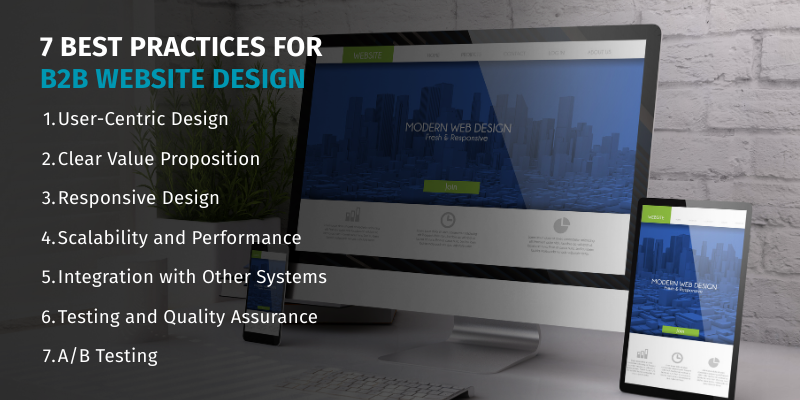A strong B2B web development strategy is essential for businesses looking to establish a solid online presence and achieve long-term success.
Thus, a well-crafted B2B website does more than just market products or services; it serves as a hub for communication, streamlines business transactions, and fosters collaboration between companies.
As the first point of contact for many potential clients and partners, it is vital to create a professional and trustworthy image right from the start.
Understanding what are five marketing strategies that retailers spend half of their annual budget on? can provide insights into how businesses allocate resources to enhance their online presence
With a strategic approach to web development, a website can be functional, scalable, secure, and adaptable to evolving business needs.
Scalability ensures that the website grows alongside the business, handling increased products, services, and clients without compromising performance.
Also, security, especially when handling sensitive B2B data, protects against breaches and unauthorized access.
Moreover, an optimized website enhances the user experience, improving efficiency and satisfaction for both businesses and clients.
In this guide, we will explore the B2B web development best practices that can help you drive conversions.
What is B2B Website Design?
B2B website design refers to creating websites tailored for businesses to interact and conduct transactions with other businesses. These websites aim to present a professional, trustworthy image while offering an efficient user experience. Integrating a digital marketing service can enhance this by driving targeted traffic and increasing engagement with your B2B audience.
Key features of B2B websites often include product catalogs, order management systems, account management tools, and secure payment processing. The design focuses on meeting the needs of business professionals who are seeking specific products or services.
While there are similarities with B2C website design, B2B sites require special considerations to address the unique demands of business clients.
B2B vs. B2C Web Development Needs
While both B2B (Business-to-Business) and B2C (Business-to-Consumer) websites require strong design and functionality, their needs are distinct. Understanding the differences between B2B Web Design vs Web Development can help businesses determine which approach best suits their objectives, ensuring that both design aesthetics and development infrastructure meet the needs of the target audience. For businesses considering platforms to build their online presence, questions like is Shopify legit often arise when evaluating tools suitable for both B2B and B2C needs.
Here’s a quick comparison between B2B vs B2C web development needs:
|
Feature |
B2B Websites |
B2C Websites |
|
Target Audience |
Businesses, decision-makers (e.g., CEOs, procurement officers) |
Individual consumers |
|
Content & Messaging |
Technical details, ROI, product features |
Emotional appeal, simplicity, quick conversions |
|
Sales Process |
Longer sales cycles, multiple touchpoints |
Quick purchases, fewer decision-makers |
|
Key Functionality |
Product catalogs, ERP system integrations, or client portals |
E-commerce features, shopping cart, payment gateway |
Understanding these distinctions helps in designing and developing a website that caters specifically to the business model, optimizing user experience, and maximizing conversions.
Explore Our Web Design & Development Services!
7 Best Practices for B2B Website Design
Effective B2B websites should prioritize the needs of their audience, ensuring that every aspect of the design, from the homepage onward, is centered around delivering value to visitors.

Here are some key best practices for designing a successful B2B website.
1. User-Centric Design
A User-Centric Design (UCD) approach is fundamental to creating a B2B website that doesn’t just attract visitors but also encourages sustained engagement and conversion.
For example, a procurement officer may need quick access to detailed product specifications and pricing information, while a CEO may be looking for high-level performance metrics or case studies.
The key elements of a user-centric design for a B2B website include:
- Custom Dashboards and Analytics: Tailored dashboards with real-time insights allow users to track relevant metrics and make data-driven decisions.
- Intuitive Navigation and Easy Product/Service Access: Simplified navigation and efficient search functions help users quickly find key information and services.
- Personalized Content and Experience: Dynamic content adapts to user behavior, offering personalized recommendations and a customized experience.
- Speed and Performance: Optimized for fast load times, ensuring smooth user interactions and reducing bounce rates.
- Mobile and Cross-Device Compatibility: Responsive design ensures a consistent experience across all devices, improving user satisfaction on-the-go.
From custom dashboards and personalized content to intuitive navigation and responsive design, every element should work together to create a seamless, efficient, and engaging experience.
2. Clear Value Proposition
A clear value proposition is one of the most critical elements of a B2B website, as it communicates directly to potential clients why they should choose your product or service over competitors.
This message should be visible and easily understood right from the homepage. The value proposition should articulate:
- What You Offer: Clearly state what products or services your business provides. Use simple and concise language that directly addresses the core offerings.
- How It Solves Problems: Emphasize how your product or service meets the specific needs of your target audience. Explain the problems it solves or the goals it helps clients achieve.
- Why It’s Valuable: Communicate the key benefits and unique selling points that differentiate your business from others in the market. This could include cost savings, efficiency, superior customer service, or any other factors that set you apart.
The value proposition should be:
- Positioned prominently on the homepage, often within the first few seconds of someone landing on the site.
- Visually distinct, using contrasting colors or bold typography to grab attention. For inspiration on creating impactful visuals, explore these advertisement examples to see how design can communicate value effectively.
- Short and impactful, ideally one to two sentences, with a clear call to action that directs users to take the next step, like learning more or contacting your sales team.
That said, a well-crafted value proposition reassures visitors they’re in the right place and helps them quickly understand the tangible benefits your business offers, improving user engagement and conversion rates.
3. Responsive Design
With an increasing number of people accessing websites via mobile devices, having a website that is mobile-friendly is crucial for reaching a broader audience.
A non-responsive website risks losing potential customers who may leave the site due to poor mobile navigation.
Here are the key elements of responsive design:
- Fluid Grids: Content is structured using a flexible grid system that automatically adjusts based on the screen size.
- Flexible Images: Images and media should scale proportionally to fit various screen sizes without causing distortion or excessive loading times.
- CSS Media Queries: These are used to adjust the design, layout, and content display based on the device’s screen size, resolution, and orientation. For example, adjusting the number of columns displayed on smaller screens or hiding unnecessary elements to streamline the experience.
- Navigation Optimization: On mobile devices, traditional navigation menus may need to be adapted into dropdown or hamburger menus to conserve space and ensure users can easily find what they need.
By focusing on responsive design, businesses ensure their website is accessible and user-friendly across all platforms, enhancing engagement, improving customer satisfaction, and driving conversions.
4. Scalability and Performance
In the fast-paced world of B2B operations, ensuring that your website is both scalable and high-performing is essential for supporting business growth and maintaining a smooth user experience.
Here are some of the major aspects of scalability:
- Modular Design: Reuse components for flexibility and growth.
- Microservices: Isolate components for independent scaling.
- Optimize Images: Compress and use lazy loading for faster page loads.
- Caching: Implement server-side and browser caching to reduce load time.
- Global Performance: Reduce latency by serving content from the nearest server.
- Reliability: Offload traffic to CDNs for better scalability and fault tolerance.
Scalability ensures that your website can evolve alongside your business, while performance optimization enhances the user experience by making the site fast and responsive.
Partnering with a professional SEO service can further optimize your site’s performance to improve search rankings and user satisfaction
5. Integration with Other Systems
Integrating your website with CRM, ERP, and third-party tools is vital for enhancing lead management, operational efficiency, and overall user experience.
These integrations streamline processes, improve data accuracy, and provide valuable insights that optimize both front-end and back-end operations.
- CRM Integration
Connecting your website with a Customer Relationship Management (CRM) system helps manage leads, track customer interactions, and automate sales processes.
CRM integration allows you to capture leads directly from the website, streamline follow-ups, and track customer data efficiently.
With integrated CRM data, you can provide tailored experiences for clients, track their journey, and ensure your sales team has up-to-date information to convert leads into customers.
-
ERP Integration
Integrating your website with an Enterprise Resource Planning (ERP) system is key for automating critical business functions such as inventory management, order processing, and financial tracking.
ERP integration ensures that updates on product availability, order status, and financial data are reflected in real-time, providing accurate information for both customers and internal teams.
- Third-Party Tool Integration
Connecting your website with third-party tools like email marketing platforms, analytics tools, and social media management systems can significantly enhance website functionality and performance.
Tools like Mailchimp or HubSpot can automate email campaigns, nurture leads, and send personalized messages, improving engagement and conversions.
Moreover, tools like Google Analytics provide insights into user behavior, website performance, and conversion rates, allowing you to make data-driven decisions and optimize marketing strategies.
To enhance your analytics capabilities, explore the best SEO reporting tools for tracking and improving your website’s search performance
Lastly, integrating social media platforms helps automate posts, manage campaigns, and track engagement, ensuring consistent communication with your audience across all channels.
6. Testing and Quality Assurance
Testing and quality assurance ensure a website is functional, user-friendly, and error-free across all platforms and browsers.
Most importantly, cross-browser compatibility must be tested on your website across all major browsers (such as Chrome, Firefox, Safari, and Edge) to ensure consistent functionality and appearance.
Next, regular usability testing involves evaluating how users interact with your website to ensure it is intuitive and easy to navigate.
It helps identify pain points, confusing navigation, or unclear calls-to-action. By observing real users, you can assess their experience and gather feedback on what works well and what doesn’t.
This process helps improve the overall user experience, ensuring that the site meets the needs of its target audience, improves user satisfaction, and leads to higher engagement and conversions.
7. A/B Testing
Regular A/B testing involves comparing different versions of website elements like CTAs, layouts, and content to determine which performs better.
To dive deeper into their role, check out what is CTA to understand how these elements drive user actions
By testing variations in a controlled environment, you can optimize user interactions, increasing conversion rates and improving user engagement.
This helps in fine-tuning the website's design and content based on actual user preferences and behaviors.
Conclusion
In B2B web development, focusing on user needs, performance, and scalability is crucial for creating a website that delivers a seamless, efficient experience while supporting business growth.
By adopting a holistic approach that integrates user-centric design, optimized performance, and scalable architecture, businesses can ensure their website not only meets current demands but also adapts to future growth. To stay ahead of technological trends, learning how to learn AI can help businesses incorporate advanced tools into their web development strategy.
This strategy will drive lead generation, enhance client satisfaction, and ultimately contribute to long-term business success. To amplify these efforts, consider partnering with a B2B marketing service to create targeted campaigns that complement your website’s design









